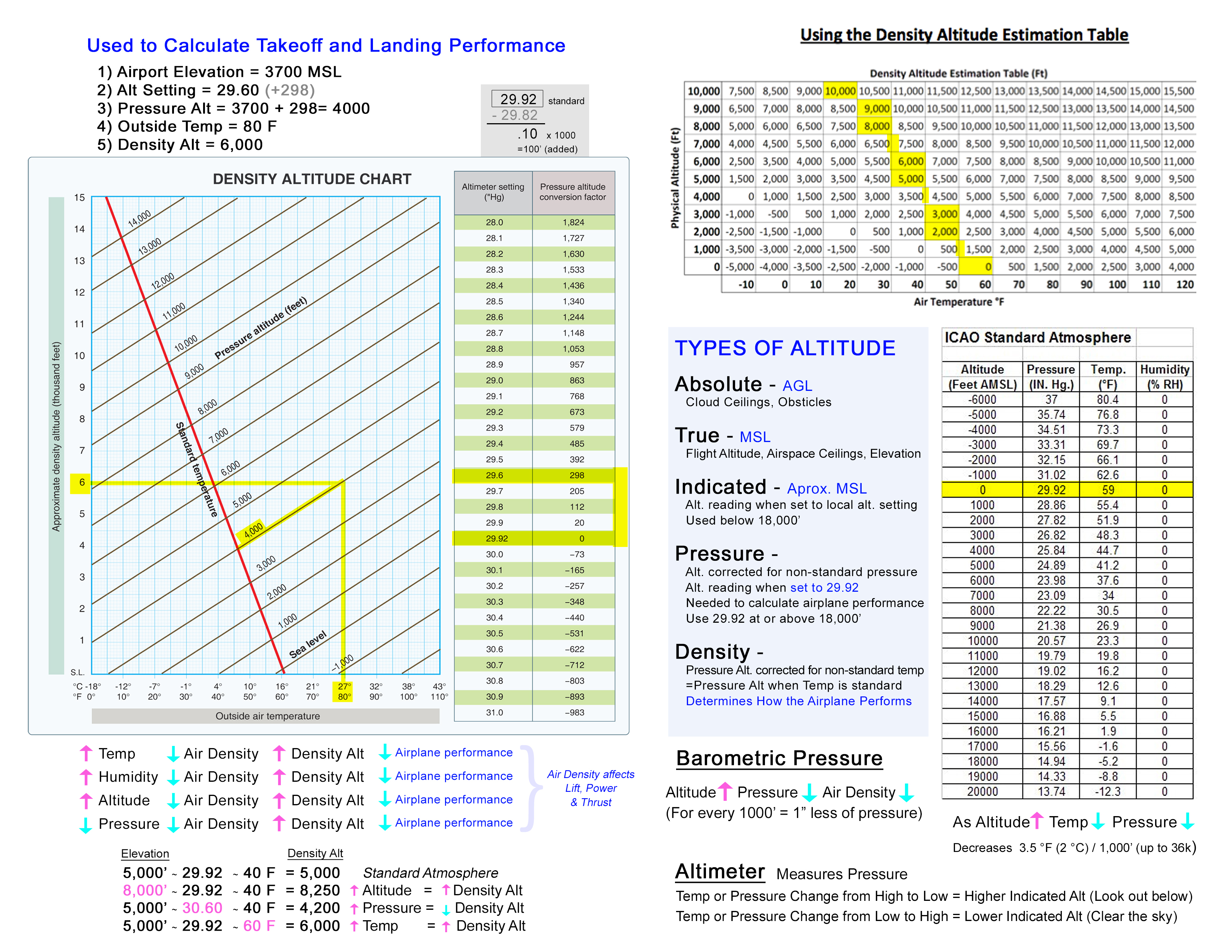

The airport is at an elevation of 1135 ft.
#Density altitude how to
To demonstrate how to read that chart let’s use the Sky Harbor shut-down as an example. This follows from the ideal gas law which says density is inversely proportional to absolute temperature. Whatever your altitude, air density is also a function of temperature. The true altitude (aka “pressure altitude”) is your height above sea level. The chart at top shows a plot of density altitude vs. Further, aircraft engines depend on oxygen for combustion, and produce less power in thinner air. That means a wing will produce only half the lift at 6000 ft compared to sea level. Where C is a coefficient that’s a function of many minor details, ρ is the density of the air, A is the area of the wing, and v is the airspeed. Wings generate less lift when moving through thinner air. Not surprisingly, higher altitude airports generally require longer runways. The chart below shows how density decreases with altitude. Lift is what holds the aircraft up against the downward pull of gravity - if F G > F L you can’t fly. The lift generated by a wing moving through air depends its size and shape and orientation, on the speed of the aircraft, and (important here) the density of the air around it. Total payload (including the weight of fuel) is also factored in. Checklist charts for the Boeing 727 did not show temperatures higher than 120 ☏, so there was no way to know if the aircraft could get off the ground before reaching the end of the runway. That flight, and others, were grounded until the matter could be resolved. One of the items on that checklist is the density altitude - a measure of how easy it is for an aircraft to generate lift.Īn America West pilot got a “red flag” on the density altitude. When a airline pilot prepares for takeoff there’s an FAA checklist that must be strictly followed and personally signed. The temperature at Sky Harbor airport hit 122 ☏ (50 ☌). This article incorporates text from Pilot's Handbook of Aeronautical Knowledge, a public domain work of the United States Government.Phoenix, Arizona was suffering through an extreme heat wave on June 26, 1990. Federal Aviation Administration, Revised 1997 Advisory Circular AC 61-23C, Pilot's Handbook of Aeronautical Knowledge, U.S.^ a b AOPA Flight Training, Volume 19, Number 4 April 2007 Aircraft Owners and Pilots Association ISSN 1047-6415.ISA temperature = 15☌ - (1.98☌/1000ft x Altitude in feet) This is an easier formula to calculate (with great approximation) Density altitude from Pressure Altitude and International Standard Atmosphere temperature deviation Density Altitude in feet = Pressure Altitude in feet + (120 x ISA deviation) T S L = standard sea level air temperature (288.15 K)Įasy formula to calculate Density altitude from Pressure Altitude T = true (static) air temperature in Kelvin (K) figure P S L = standard sea level atmospheric pressure (101.325 kPa) The aircraft service ceiling (maximum altitude which can be attained) will be lower due to both lower power output and reduced lift, reducing the ability to fly above obstacles such as mountainsĭensity altitude can be calculated from atmospheric pressure and temperature (assuming dry air).The aircraft will climb more slowly as the result of reduced power production.The aircraft will need to move faster to attain the same lift - this implies both a longer roll down the runway before liftoff and a higher speed which must be maintained when airborne to avoid stalling.The aircraft will accelerate more slowly down the runway as a result of reduced power production.The power output of the engine - power output depends on oxygen intake, so the engine output is reduced as the equivalent "dry air" density decreases and produces even less power as moisture displaces oxygen in more humid conditions.Īs a result of a density altitude that is higher than the actual physical altitude, the following effects are observed :.The efficiency of the propeller - which for a propeller (effectively an airfoil) behaves similarly to lift on wings.The lift generated by the wings - reduction in air density reduces the wings lift, while the effect of humidity on lift is negligible.Air density is perhaps the single most important factor affecting airplane performance.


 0 kommentar(er)
0 kommentar(er)
